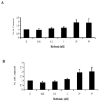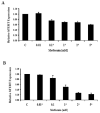Metformin is a potent inhibitor of endometrial cancer cell proliferation--implications for a novel treatment strategy
- PMID: 19822355
- PMCID: PMC2789879
- DOI: 10.1016/j.ygyno.2009.09.024
Metformin is a potent inhibitor of endometrial cancer cell proliferation--implications for a novel treatment strategy
Abstract
Objectives: Obesity and diabetes are strong risk factors that drive the development of type I endometrial cancers. Recent epidemiological evidence suggests that metformin may lower cancer risk and reduce rates of cancer deaths among diabetic patients. In order to better understand metformin's anti-tumorigenic potential, our goal was to assess the effect of metformin on proliferation and expression of key targets of metformin cell signaling in endometrial cancer cell lines.
Methods: The endometrial cancer cell lines, ECC-1 and Ishikawa, were used. Cell proliferation was assessed after exposure to metformin. Cell cycle progression was evaluated by flow cytometry. Apoptosis was assessed by ELISA for caspase-3 activity. hTERT expression was determined by real-time RT-PCR. Western immunoblotting was performed to determine the expression of the downstream targets of metformin.
Results: Metformin potently inhibited growth in a dose-dependent manner in both cell lines (IC(50) of 1 mM). Treatment with metformin resulted in G1 arrest, induction of apoptosis and decreased hTERT expression. Western immunoblot analysis demonstrated that metformin induced phosphorylation of AMPK, its immediate downstream mediator, within 24 h of exposure. In parallel, treatment with metformin decreased phosphorylation of S6 protein, a key target of the mTOR pathway.
Conclusions: We find that metformin is a potent inhibitor of cell proliferation in endometrial cancer cell lines. This effect is partially mediated through AMPK activation and subsequent inhibition of the mTOR pathway. This work should provide the scientific foundation for future investigation of metformin as a strategy for endometrial cancer prevention and treatment.
Conflict of interest statement
Figures






References
-
- Fader AN, Arriba LN, Frasure HE, von Gruenigen VE. Endometrial cancer and obesity: epidemiology, biomarkers, prevention and survivorship. Gynecol Oncol. 2009;114(1):121–7. - PubMed
-
- von Gruenigen VE, Gil KM, Frasure HE, Jenison EL, Hopkins MP. The impact of obesity and age on quality of life in gynecologic surgery. Am J Obstet Gynecol. 2005;193(4):1369–75. - PubMed
-
- Jemal A, Siegel R, Ward E, et al. Cancer statistics, 2008. CA Cancer J Clin. 2008;58(2):71–96. - PubMed
-
- Chia VM, Newcomb PA, Trentham-Dietz A, Hampton JM. Obesity, diabetes, and other factors in relation to survival after endometrial cancer diagnosis. Int J Gynecol Cancer. 2007;17(2):441–6. - PubMed
-
- Calle EE, Rodriguez C, Walker-Thurmond K, Thun MJ. Overweight, obesity, and mortality from cancer in a prospectively studied cohort of U.S. adults. N Engl J Med. 2003;348(17):1625–38. - PubMed
Publication types
MeSH terms
Substances
Grants and funding
LinkOut - more resources
Full Text Sources
Other Literature Sources
Research Materials
Miscellaneous

